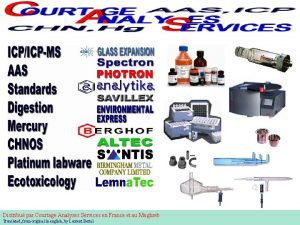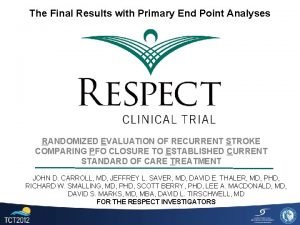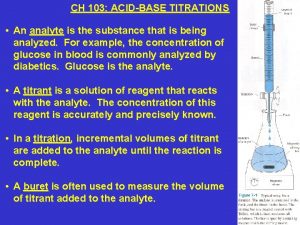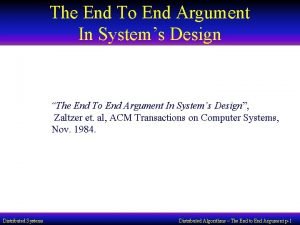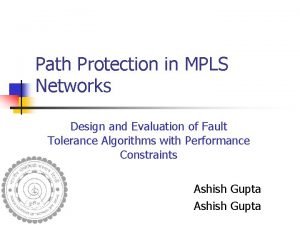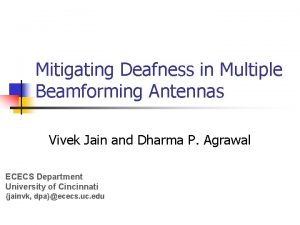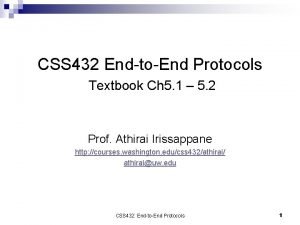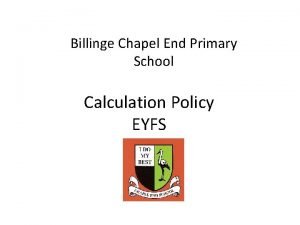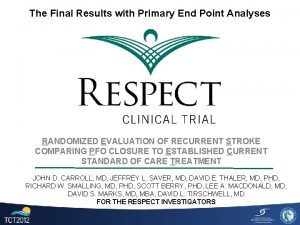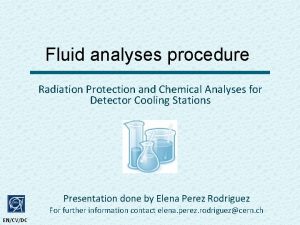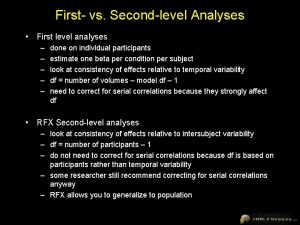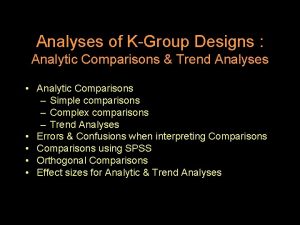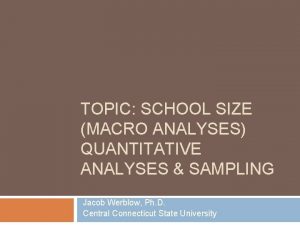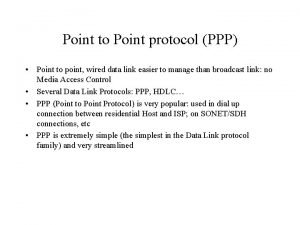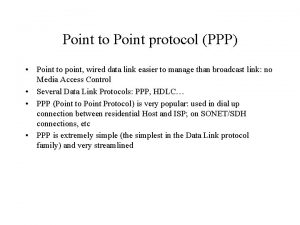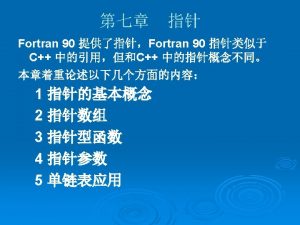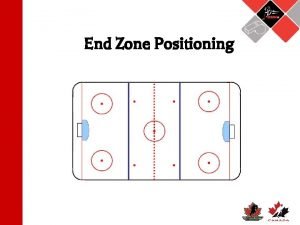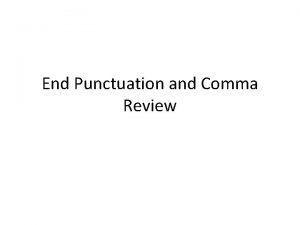The Final Results with Primary End Point Analyses






























- Slides: 30

The Final Results with Primary End Point Analyses RANDOMIZED EVALUATION OF RECURRENT STROKE COMPARING PFO CLOSURE TO ESTABLISHED CURRENT STANDARD OF CARE TREATMENT JOHN D. CARROLL, MD, JEFFREY L. SAVER, MD, DAVID E. THALER, MD, PHD, RICHARD W. SMALLING, MD, PHD, SCOTT BERRY, PHD, LEE A. MACDONALD, MD, DAVID S. MARKS, MD, MBA, DAVID L. TIRSCHWELL, MD FOR THE RESPECT INVESTIGATORS

Disclosure Statement of Financial Interest § Within the past 12 months, John Carroll and the University of Colorado (his employer) have had a financial interest/arrangement or affiliation with the organization listed below: 2 1. Paid to University Physician Inc. of the University of Colorado School of Medicine

Background: Cryptogenic Stroke and PFO § Cryptogenic stroke remains a major challenge § PFO-related strokes, i. e. due to paradoxical embolism, have been strongly implicated as a possible cause § Patients age 20 -54 are now a larger percentage of all stroke patients and among first ever strokes in the younger population there is growth in ischemic strokes 1 § Cost of stroke is significant, with over $94 B 2, 3 spent each year in the US and EU alone – cost implications with young patients are immense, based on the loss of productivity and long-term care § The results of PFO closure trials have included positive observational studies and one negative randomized trial § The RESPECT trial was designed with a well-defined stroke population, a statistical design appropriate for expected low recurrent event rates, and used a device with an excellent safety record 1. 2. 3. Kissela, BM, Khoury, JC, Alwell, K, et al. Age at stroke Temporal trends in stroke incidence in a large, biracial population. Neurology 2012; 79: 1781 -1787 Roger, V, Go, A, Lloyd-Jones, D, et. Al. Heart Disease and Stroke Statistics – 2012 Update: A Report from the American Heart Association. Circulation. 2012; 125: e 2 -e 220 Allender, S, Scarborough, P, Peto, V, et al European cardiovascular disease statistics 2008 3

Pathophysiology of PFO and Paradoxical Embolism Normal appearing atrial septum Agitated saline study demonstrating right to left shunting through the PFO Septum Secundum Septum Primum Blood clot passing through the PFO becoming a paradoxical embolism 4

Trial Design § Multicenter: 69 Sites (62 US, 7 Canada) § Prospective, 1: 1 Randomized stratified by site and atrial septal aneurysm § Device Group (Test): § Closure with the AMPLATZER™ PFO Occluder plus medical therapy § Medical Group (Control): 5 Medical Treatment Regimens: § Aspirin § Clopidogrel § Warfarin § Aspirin with dipyridamole § Aspirin with clopidogrel 1 § Sample Size: Event-driven – continued enrollment until 25 th endpoint Primary Analyses Four protocol-specified analyses with raw count primary analysis Trial Status Trial was conducted under an Investigational Device Exemption (IDE) Sponsor St. Jude Medical, St. Paul, MN *Study initiated under AGA Medical, Plymouth, MN 5 1. Aspirin with clopidogrel was removed from the protocol in 2006 based on changes to the AHA/ASA treatment guidelines

Study Governance and Organization Executive Steering Committee § John D. Carroll, MD, University of Colorado/University of Colorado Hospital, § § Department of Medicine (Cardiology) Jeffrey L. Saver, MD, University of California, Los Angeles, Department of Neurology Richard W. Smalling, MD, Ph. D, University of Texas/Memorial Hermann Heart and Vascular Institute, Division of Cardiology § David E. Thaler, MD, Ph. D, Tufts University/ Tufts Medical Center, Department of Neurology Independent Review § § Independent Clinical Events Committee (CEC) Independent Data Safety and Monitoring Board (DSMB) Independent Neurological Executive Committee Core Laboratories: § Hematology (Quintiles) § Echocardiography (CVR Consulting, PC) Statistical Oversight § Independent Biostatistician: Berry Consultants 6

AMPLATZER PFO Occluder § Percutaneous, transcatheter device § Self-expanding, double-disc design § Nitinol wire mesh with polyester fabric/thread § Radiopaque marker bands § Sizes: 18, 25, 35 mm AMPLATZER PFO Occluder* § Recapturable and repositionable 7 *CAUTION: Investigational device in the United States. Limited by Federal (or U. S. ) law to investigational use. Not available for sale in the U. S.

Inclusion/Exclusion Criteria § Inclusion Criteria: § Patients (ages 18 to 60) with PFO who have had a cryptogenic stroke within 270 days § Stroke defined as acute focal neurological deficit, presumed to be due to focal ischemia, and either symptoms persisting 1) ≥ 24 hours, or 2) < 24 hours with MR or CT confirmed new, neuroanatomically relevant, cerebral infarct § PFO defined as TEE visualization of micro-bubbles in the left atrium within 3 cardiac cycles of their appearance in the right atrium at rest and/or during Valsalva release § Key Exclusion Criteria: § Cerebral, cardiovascular, and systemic conditions that suggest other mechanisms for stroke. Examples: § Carotid disease, atrial fibrillation, cardiomyopathy, etc § Arterial hypercoagulable states § Contraindications: § To aspirin or clopidogrel § Uncontrolled diabetes mellitus or hypertension § Other sources of right to left shunt § Anatomical to device placement § Any other reason to expect limited life expectancy, inability to attend follow-up visits, or inability to provide informed consent 8

Primary and Secondary Endpoints § Primary Endpoints § Recurrence of a nonfatal ischemic stroke or § Fatal ischemic stroke or § Early post-randomization death defined as all-cause mortality § Device group – within 30 days after implant or 45 days after randomization, whichever occurs latest § Medical group – within 45 days after randomization § Secondary Endpoints § Complete closure of the defect demonstrated by transesophageal echocardiography (TEE) and bubble study at the 6 -month follow-up (Device Group) § Absence of recurrent symptomatic cryptogenic nonfatal stroke or cardiovascular death § Absence of transient ischemic attack (TIA) 9

Power Analysis and Event Driven Design § Estimated rate of primary efficacy events at 2 years was 4. 3% in the medical group and 1. 05% in the device group § An event driven trial design was employed since event rates were estimated to be low § Decision rules for trial stopping & power were based on event raw counts and assumed equal follow-up in both study groups § Enrollment was stopped December 29, 2011 when the decision rule of 25 primary endpoint events was reached which led to this presentation of results 10

Primary Endpoint Analyses Population The 25 adjudicated endpoint events § § All primary endpoints were recurrent ischemic strokes. No study related deaths § Analytic data set: observational period from the beginning of the trial to the date when the 25 th primary endpoint event was adjudicated 11

Trial Results 12

Subject Distribution TEE with bubble study at 6 months 1. Aspirin + clopidogrel was removed from the protocol in 2006 based on changes to the AHA/ASA treatment guidelines 13

Baseline Characteristics 4. 1. Statistics are represented as either mean (standard deviation) or percentages 2. Based on a 2 -sample t-test (age), Wilcoxon-Mann-Whitney test (days from stroke to date randomized), and Fisher’s Exact test (sex) 3. Numbers vary by site; Age N=968; Shunt N=969 14

Baseline Medical Characteristics No differences between the two groups 1. For Device Group N=498 2. P-value calculated using Fisher’s Exact test 15

Serious Adverse Events Adjudicated as Related to Procedure, Device, or Study 1. 2. 3. 4. For all AE’s, atrial fibrillation occurred in 3. 0% versus 1. 5% in the device and medical groups respectively, p=0. 13 Pericardial tamponade is a subset of major bleeds, and thus counted in the major bleed category as well For all SAEs, pulmonary embolism occurred in 1. 2% and 0. 2% in device and medical groups, respectively, p=0. 124 1 case of right atrial thrombus resulted in abandonment of device implant procedure (no device received); 1 case of right atrial thrombus (located inferiorly) not attached to device detected in patient with DVT and PE 4 months after procedure 5. 1 ischemic stroke one week post implant; 1 five months post implant with finding of severe shunting related to previously undiagnosed sinus venosus defect, requiring surgical closure 6. For all SAEs, there were 3 device group deaths (0. 6%) and 6 medical group deaths (1. 2%) all of which were not study related, p= 0. 334 7. P-values are calculated using Fisher’s Exact test 16

Device Performance Maximum Residual Shunting at Rest and Valsalva at 6 Months Grade 0: 72. 7% Grade 1: 20. 8% Grade 2 -3: 6. 5% 1. Defined as successful delivery and release of the device for subjects in whom the delivery system was introduced into the body 2. Defined as successful implantation with no reported in-hospital serious adverse events 3. Defined as complete obliteration or trivial residual shunting (Grade 0 or I at rest and Valsalva) at 6 months, adjudicated by echo core lab 17

Treatment Exposure and Follow-up § Total population with greater than 2, 550 years of follow-up § Device group had greater follow-up (fewer drop-outs) § 48 drop-outs in the device group versus 90 in the medical group 18 1. P-value calculated using Wilcoxon-Mann-Whitney test

Primary End Point Analysis – Intent to Treat (ITT) Raw Count Cohort Abbreviations: D = Device group; M= Medical group § The primary analysis using the raw count of the ITT cohort was deemed invalid because the exposure to the two treatment options was unequal due to a greater drop-out rate in the medical group § The protocol specified that, if unequal drop-out occurred, then survival functions for the time-to-endpoint event for each treatment group would be used to provide an exposure-stratified comparison § Survival analysis methods would then be used at a two-sided 0. 05 level using the log-rank statistic. Hazard ratios were calculated using a Cox proportional-hazards model 1. Relative risk is represented by the Mantel-Haenszel odds ratio 2. P-value is 2 -sided and calculated using Fisher ’s Exact test 19

Primary Endpoint Analysis – ITT Cohort 50. 8% risk reduction of stroke in favor of device § 3/9 device group patients did not have a device at time of endpoint stroke 20 1. Cox model used for analysis

Primary Endpoint Analysis – Per Protocol Cohort 63. 4% risk reduction of stroke in favor of device § The Per Protocol (PP) cohort includes patients who adhered to the requirements of the study protocol 1. Cox model used for analysis 21

Primary Endpoint Analysis – As Treated Cohort 72. 7% risk reduction of stroke in favor of device § The As Treated (AT) cohort demonstrates the treatment effect by classifying subjects into treatment groups according to the treatment actually received, regardless of the randomization assignment 1. Cox model used for analysis 22

Totality of Evidence and NNT 46. 6%-72. 7% risk reduction of stroke in favor of device Totality of Evidence Number Needed to Treat (NNT) 1. P-values: ITT Raw Count is calculated using Fisher ’s Exact test; all other P-values are calculated using log-rank test 2. The NNT is the average number of subjects that need to be treated with the AMPLATZER™ PFO Occluder in order to prevent one stroke in the respective time intervals. The NNT is calculated as the reciprocal of the difference between the control arm and device arm event rates 3. Calculated using the Kaplan-Meier estimated event rates for each treatment group 23

Subpopulation Differential Treatment Effect 24

Recurrent Cerebral Infarct Size 1 Methods pre-specified; analysis post-hoc § This exploratory analysis of site-reported recurrent cerebral infarct size is provocative in suggesting that recurrent ischemic strokes in the medical versus device group are not only more frequent but also larger 1. Recurrent infarct size reported on primary endpoint population 2. P-value based on Fisher’s Exact test 25

Limitations § Differential drop-out rate § Some medical group patients left study and underwent off-label closure § ITT Results § Raw count analysis invalid due to differential treatment exposure § Borderline p-value for ITT-KM cohort § Even though 3/9 device patients with recurrent ischemic stroke did not have device in place when stroke occurred § PP and AT cohorts are relevant to assessing treatment § Totality of evidence must be considered § Sub-group analysis with only 25 events is exploratory in nature § Clinically, the atrial septal aneurysm and shunt size findings are relevant and support mechanism of action § RESPECT took over 8 years to complete § Yet, this produced longer term outcomes than any other study particularly important for young stroke patients who face a risk of recurrent stroke for decades § Benefit became especially prominent 2 -5 years after device placement 26

Conclusion § For carefully selected patients with history of cryptogenic stroke and PFO, the RESPECT Trial provides evidence of benefit in stroke risk reduction from closure with the AMPLATZER PFO Occluder over medical management alone § Primary analysis of ITT cohort was not statistically significant but trended towards superiority while secondary analyses suggested superiority § Stroke risk reduction was observed across the totality of analyses with rates ranging from 46. 6% - 72. 7% § PFO closure with the AMPLATZER PFO Occluder exposes patients to a very low risk of device- or procedure-related complications § Results of the RESPECT Trial have substantial import for the treatment of patients with a history of cryptogenic stroke and PFO § Follow-up of patients is on-going and will continue to provide additional longer term information regarding benefits, risks, and differential treatment effects in sub-populations 27

Study Sites and Principal Investigators 29

Trial Sites Top 5 enrollers noted 29

Patient Disposition: Randomization and Follow-Up * Completed primary endpoint follow-up ** Discontinued prior to primary endpoint 30
 Molecular ecological network analyses
Molecular ecological network analyses Importance of critical thinking in nursing process
Importance of critical thinking in nursing process Rhetorical analysis thesis example
Rhetorical analysis thesis example Icp courtage
Icp courtage Primary end point
Primary end point Difference between endpoint and equivalence point
Difference between endpoint and equivalence point End result of an activity.
End result of an activity. Psle results 2013
Psle results 2013 What is stroke volume
What is stroke volume Stroke volume
Stroke volume Front end and back end in compiler design
Front end and back end in compiler design Front end back end compiler
Front end back end compiler Kolondivertikulose
Kolondivertikulose Yichao zhou
Yichao zhou End to end argument
End to end argument End to end accounting life cycle tasks
End to end accounting life cycle tasks Protect
Protect End to end delay
End to end delay End to end
End to end Comet transformer
Comet transformer Multiple procurement cycles
Multiple procurement cycles Chapel end primary school
Chapel end primary school Signe de ponctuation
Signe de ponctuation Hát kết hợp bộ gõ cơ thể
Hát kết hợp bộ gõ cơ thể Ng-html
Ng-html Bổ thể
Bổ thể Tỉ lệ cơ thể trẻ em
Tỉ lệ cơ thể trẻ em Gấu đi như thế nào
Gấu đi như thế nào Tư thế worms-breton
Tư thế worms-breton Hát lên người ơi alleluia
Hát lên người ơi alleluia Môn thể thao bắt đầu bằng chữ đua
Môn thể thao bắt đầu bằng chữ đua



